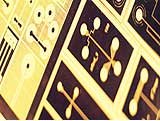
MIGUEL BOYAYANDevices with microchannels, made with copying machine toner, at the prototype stageMIGUEL BOYAYAN
Tiny structures the size of a matchbox, which work like microlaboratories for chemical analyses, are being indicated as a replacement for the traditional instruments currently used for blood tests. With a single drop of blood taken from the patient’s fingertip, the physician will be able, in his own office, process the material and immediately make a diagnosis and, if necessary, prescribe the appropriate treatment. Tests done in the laboratory by a research group coordinated by Professor Claudimir Lucio do Lago, of the Chemistry Institute of the University of São Paulo (USP), showed that it is possible to produce these small items in a short space of time and at a low cost, contrary to other techniques used for the production of this microequipment.
The low price of each device – which measure 2 by 3 cm. – is in the region of US$ 0.02. “A single transparency makes it possible to produce some 50 devices in a matter of a few hours”, says Claudimir, “whereas the traditional ones, made of glass or quartz, cost between dozens and hundreds of dollars a unit, the prices asked by companies that manufacture these microstructures abroad.”
The new technique will be useful for the production of prototypes serving to assess the composition of rainwater, of fuel alcohol, of wines, and of the sugar content in drinks, among other applications. To do so, these products have microchannels where the fluids under analysis are processed. The novelty from the group for USP lies in building these microchannels using only material found in offices, like computers, transparencies and toner (the black powder used in copying machines).
This technique makes it possible, in just one hour, to create a prototype and to test it, while with the method traditionally used weeks or even months are needed to assess whether the planned microstructure really works. Claudimir points out that the National Synchrotron Light Laboratory (LNLS) has resources for making more elaborate items, with deeper channels, as well as the Integrable Systems Laboratory (LSI), of the Polytechnic School at USP.
But the process carried out by these laboratories is done in multiple stages, with technological secrets and one limitation: if only one of these stages fails, all the tests have to be restarted. “It is expensive, because it calls for a really heavy infrastructure, and it takes time, because of the various stages”, the researcher explains. “Our initial idea to start with, of developing a process that would make it possible to dilute the production costs, with the rapid production of a prototype, was met with the use of toner”, Claudimir commemorates. He was able to count on the help of three people studying for a doctorate and one doing postdoctoral studies.
One-way product
The new process was patented with the support of FAPESP’s Nucleus for Patenting and Licensing Technology (Nuplitec). The creation of the microchannels begins on the computer, with the outline of the route done with the assistance of the Corel Draw program. The first print-off, just to test whether the design is correct, is done on common paper, and the definitive one on a sheet of transparent plastic. This sheet is stuck to another one in a laminator (a machine to cover documents with plastic), forming a sort of polymer sandwich. The thickness of the layer of toner (with a few micrometers (thousandths of millimeters)), determines the height of the channel, while the resolution of the printing process and the granulometry of the toner account for its breadth. “Due to the low cost of the raw material and of manufacture, these structures can be useful in making disposable microminiaturized devices”, says Claudimir.
But, in his assessment, for them to be produced on a large scale, some aspects of the construction of the equipment and of the development of materials have to be perfected by industry. “We are working with the laboratory’s existing resources, but we have no way of developing a laser printer specifically for making microdevices”, the researcher observes. “Not to mention that the size of the grains of toner was developed for normal printing, and its chemical composition is intended only for paper and transparencies, and not to other materials more appropriate for chemical analyses.” According to Claudimir, even though the final product may be constructed with another technique, the rapid prototyping conceived at the Chemistry Institute is going to arouse interest, because the process does not generate so much industrial waste as the traditional method for micromanufacture used by companies.
Multiple uses
The idea of using the laser printing process for the purpose of micromanufacture arose in 1999, when Claudimir was finalizing a project on piezoelectric quartz crystals for analyzing boron and germanium, published in Analytical Chemistry, the main magazine on analytical chemistry in the world. One of the parts of the project dealt with detection in capillary electrophoresis, an analytical technique that uses high voltage to separate the chemical compounds, by means of a silicon tube similar to a copper wire, and then to quantify them. “This method was responsible for the great impulse given to the genome projects, and it is intimately linked to the development of techniques for analysis that use micromanufactured devices”, he says.
The United States, Germany, England France and Japan are the main markets for microlaboratories. In Brazil, the demand for these products is still small, but it may increase, if the prices are not prohibitive. Those interested include companies in the area of clinical analyses, from the pharmaceutical sector, and in environmental control. But the food and drink industries are also candidates for using these miniature quality control systems.
The project
Micromanufacturing Process Using Toner as a Structural Material (nº 01/00881-0); Modality Intellectual Property Support Program (PAPI); Coordinator Claudimir Lucio do Lago – IQ/USP; Investment R$ 5,000.00

